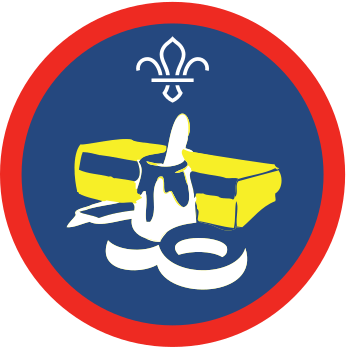
Sew your own flag
You’ll need
- Pens or pencils
- Scissors
- Rulers
- Needle and thread (various), one per person
- Pins
- Fabrics, various colours depending on designs
- Cord, enough that each person has about a metre
Before you begin
- Look at the ‘Scout Patrol badges’ sheet when you’re choosing fabrics for this activity. You’ll see the colours that are needed for each Patrol badge, which you may wish to replicate on your group’s Patrol flags. Traditional Patrols all have their own emblem and colour scheme. If it’s tough to get specific colours or the right fabric dyes, get a selection of colours and have the group create their own, unique Patrol designs. Fall in, pineapple Patrol!
- Fabrics can be found in craft and hobby stores, as well as online. This is also where you’ll find most of the equipment for this activity (like needles and thread). If possible, try to repurpose scrap fabric or old clothes for this activity.
Run the activity
- Split everyone into small groups. Each group will need a large sheet of paper and pencil per person. Have everyone draw the outline of a flag for their Patrol. The flag may be any shape, though a triangle of 40cm from point to base usually works best. Each person should also have a look at the fabrics available and choose the colours they’ll be using on their flag.
- Give out scissors to each group. Supervise as they cut out the templates of their designs. If flags are going to be more than one colour, it may be easier for groups to cut the cut-out into its different coloured parts (such as a red side and a blue side), so that they can pin them to the different fabrics.
- Give out more paper or use leftover scraps. Have everyone draw the emblem for their flag and choose a fabric colour for it.
Remember that emblems should be small enough to fit in the centre of the flag, and large enough that they’re easy to recognise.
- Have everyone collect the fabrics they chose. Use fabric scissors to cut a suitable length for each person using it. When everyone has their fabric, they should place their templates on the chosen fabric and draw around them with chalk.
- Give out the fabric scissors and pins to everyone so that everyone can cut out their fabric pieces and pin them together. It's OK to overlap the fabric pieces.
This is a good time to make sure everyone’s up to the same point in the activity. Go between the groups with the fabric scissors and see how they’re getting on. If anyone’s struggling, have someone else in their group who’s more comfortable assist. If groups are waiting for fabric scissors, give them needles and thread and challenge them to thread the eye of the needle!
- When cutting out emblems, remind everyone to cut their emblem from the fabric twice (for both sides of the flag), flipping over the template to do the reverse.
Supervise this and be ready with spare fabric, just in case.
- Those who haven’t already should take a needle and thread. If there’s a choice of thread colours, let everyone choose something they like. They may wish to pick the same colour as their fabric, to hide the stitching, or something that makes the stitching stand out. Thread the needles and cut each person a suitable length of thread.
- Give out the ‘Illustrated instructions’ sheet. Everyone should follow the images to sew their flag pieces together with their needles and thread. They may remove their pins as they do so. Each person should use a ‘back stitch,’ as this is neat and secure.
- When the flags are sewn, give out lengths of cord to each person. Ideally, the cord should be three times the length of the pole-side of the flag. With pins, attach the middle third of the cord to the pole-side of the flag, taking care to leave the same length of excess cord on both ends.
- With needle and thread, stitch the cord into place, removing the pins as you go. The cord can then be tied to a rope or pole, allowing the flag to be flown.
Reflection
Sewing is a really useful skill with many applications. It can help you repair everything from clothes and equipment to furniture and decorations. How did you work together in groups to overcome the fiddly parts of this activity, like threading the needles and sewing the fabric? How did you decide what flag designs to do: did you and your patrol make flags like your patrol badge, or did you reimagine your badge design in a new way?
Safety
All activities must be safely managed. You must complete a thorough risk assessment and take appropriate steps to reduce risk. Use the safety checklist to help you plan and risk assess your activity. Always get approval for the activity, and have suitable supervision and an InTouch process.
- Sharp objects
Teach young people how to use sharp objects safely. Supervise them appropriately throughout. Store all sharp objects securely, out of the reach of young people.
- Scissors
Supervise young people appropriately when they’re using scissors. Store all sharp objects securely, out of the reach of young people.
Super sewers may like to try their hand at making badges or banners for their patrol using embroidery.
Sewing can be fiddly. Supervise and have everyone work together to help each member of each group complete their flag.
All Scout activities should be inclusive and accessible.
Improving your sewing skills could be a part of your Personal Challenge Award.
Young people should be allowed to decide what their patrols are and whether they should change. Traditional emblems can easily be replaced with favourite animals, plants or objects.

